1061 scholarly books by Catholic University of America Press and 32
start with G
1061 scholarly books by Catholic University of America Press and 32
1061 scholarly books by Catholic University of America Press
32 start with G start with G
32 start with G start with G
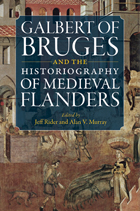
Galbert of Bruges and the Historiography of Medieval Flanders
Jeff Rider
Catholic University of America Press, 2009
Edited by two of the world's most prominent specialists on Galbert today, Jeff Rider and Alan V. Murray, this book brings together essays by established scholars who have been largely responsible for the radical changes in the understanding of Galbert and his work that have occurred over the last thirty years and essays by younger scholars.
[more]
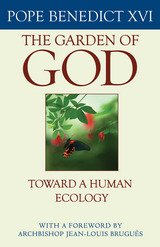
The Garden of God
Pope Benedict XVI
Catholic University of America Press, 2014
This book gathers together the audiences, addresses, letters, and homilies of Benedict on a wide-ranging set of topics that deal with the world about us. The major themes and connections he explores are creation and the natural world; the environment, science, and technology; and hunger, poverty, and the earth's resources.
[more]
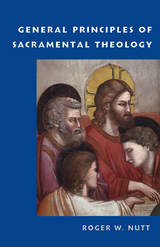
General Principles of Sacramental Theology
Roger W. Nutt
Catholic University of America Press, 2017
General Principles of Sacramental Theology addresses a current lacuna in English language theological literature. Bernard Leeming’s highly respected book Principles of Sacramental Theology was published more than sixty years ago. Since that time, there has been a noted decrease, especially in English language sacramental theology, in treatments of the basic topics and principles – such as the nature of the sacraments of signs, sacramental grace, sacramental character, sacramental causality, sacramental intention, the necessity and number of the sacraments, sacramental matter and form, inter alia – which apply to all of the sacraments. This book will be of use in seminary, graduate, and undergraduate courses. The sacraments play an irreplaceable role in pursuing a Universal Call to Holiness that is so central to Vatican II’s teaching.
[more]
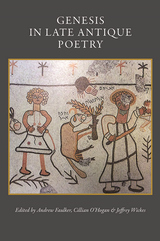
Genesis in Late Antique Poetry
Andrew Faulkner
Catholic University of America Press, 2022
The biblical book of Genesis stands nearly without parallel in the shared history of Judaism, Christianity, and Islam. Because of its abiding importance to late antique theology and practical life across religious boundaries, it gave rise to a wide range of literary responses. The essays in this book study an array of Jewish and Christian responses to Genesis as they took shape in specific literary forms—the unique genres of late antique poetry. While late antique and early medieval Jews and Christians did not always agree in their interpretations of Genesis, they participated broadly in a shared culture of poetic production. Some of these poetic genres paralleled one another simply as distinct examples of metered speech, while others emerged in conversation and through mutual influence. Though late antique poems developed in a variety of languages and across religious boundaries, scholarly study of late antique poetry has tended to isolate the phenomenon according to language. As a corrective to this linguistic isolation, this book initiates a comparative conversation around the Jewish and Christian poetry that emerged in late antique Aramaic, Greek, Hebrew, Latin, and Syriac. Tending equally to exegetical content and literary form, the essays in this book sit at the intersection of a variety of scholarly conversations—around the history of biblical exegesis, the formation of late antique and early medieval literature and literary culture, and the comparative study of Judaism and Christianity.
[more]
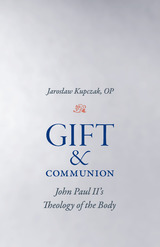
Gift and Communion
Jaroslaw Kupczak
Catholic University of America Press, 2014
Gift and Communion offers a critical presentation of John Paul II's theology of the body, understood in the light of Christian theological tradition. The main thesis of the book is that John Paul II's theology of the body forms a new, inspiring approach to Christian ethics and the theology of marriage and family, as well as to theological anthropology. A central thrust of Gift and Communion is to treat theology of the body - as it deserves - in all its philosophical and theological seriousness and to present it as an important stage in the historical development of Catholic theology
[more]
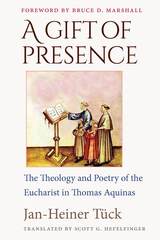
A Gift of Presence
The Theology and Poetry of the Eucharist in Thomas Aquinas
Jan Heiner Tück
Catholic University of America Press, 2018
Jan-Heiner Tück presents a work that explores the sacramental theology, lived spirituality, and Eucharistic poetry of the Church’s doctor communis, St. Thomas Aquinas. Although Aquinas’ Eucharistic poetry has long occupied an important place in the Church’s liturgical prayer and her repertoire of sacred music, the depth of these poems remains hidden until one grasps the rich sacramental theology underlying it. Consequently, Tück first offers a detailed but approachable primer of Aquinas’ theology of the sacraments, before diving deeply into the Angelic Doctor’s theology and poetry of the Eucharist. The Scriptural accounts stand at the heart of the systematic framework developed by Aquinas, and thus significant attention is devoted to showing the harmony between the accounts of Christ’s passion and the detailed exposition of the Summa theologiae. Moreover, the Eucharistic controversies of the ninth and eleventh centuries provide the contrapuntal context in which Aquinas did his thinking, praying, and writing. Not surprisingly, therefore, the response he crafts to these controversies draws upon both speculative powers and contemplative prayer, brought together in the unity of Aquinas’ theology and spirituality. The net result is a twofold treasure for the Church: a careful systematic presentation of Eucharistic theology and the lived devotional expression of the same in the carefully constructed—and now much beloved—stanzas of Pange lingua gloriosi, Lauda Sion, Adoro te devote, etc. By revealing the lively interplay of the saint’s powerful speculative intellect and a heart steeped in love for the Eucharistic Lord, Tück offers a sophisticated exposition of Aquinas’ Eucharistic poetry and the roots it sinks into a wider theological framework. Finally, the contemporary significance and power of Aquinas’ work is drawn out, not only in the rarefied realm of intellectual inquiry but also in the everyday expanse of ordinary life.
[more]
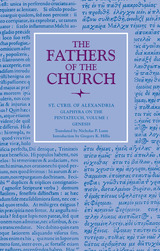
Glaphyra on the Pentateuch, Volume 1
Nicholas P. St. Cyril of Alexandria
Catholic University of America Press, 2019
Cyril of Alexandria (ca. 376–444) is best known for his defense of orthodoxy at the time of the Nestorian controversy over the nature of Christ. However, by far the larger part of Cyril’s literary output consisted of commentaries on books of both Old and New Testaments, written before the Christological debate was sparked off in 428. One of these works, of major proportions, was the so-called Glaphyra (“elegant comments”) on the Pentateuch. This comprises a total of thirteen separate “books,” or volumes: seven on Genesis, three on Exodus, and one each on Leviticus, Numbers and Deuteronomy. The comments primarily concern the narrative portions of the Pentateuch, hence the greater space given to Genesis, though a number of the legal prescriptions are also treated. This present volume, containing all seven books on Genesis, is the first of a projected two-volume set which will offer a translation of the whole Glaphyra for the first time in English. Cyril’s aims within the commentary are both theological and pastoral. His chosen method begins with a consideration of the historia. Here the Alexandrian patriarch deals with the text at the literal level. At this stage he explains any historical, cultural, and at times even linguistic and textual issues presented within the passage, which is then followed by some theological instruction or lessons of a more practical nature based upon the literal interpretation. The exposition then moves on to the theoria. This is Cyril’s preferred term for the contemplation of the spiritual sense, that is to say, the mystery of Christ which he firmly held lay hidden beneath the surface of the Old Testament text. With great adeptness and consistency Cyril identifies elements within the ancient narratives as figures, or “types and shadows,” of the Lord Jesus Christ, the Church, and the teachings of the gospel.
[more]
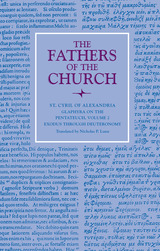
Glaphyra on the Pentateuch, Volume 2
St. Cyril of Alexandria
Catholic University of America Press, 2019
The translation of the commentary of Cyril of Alexandria (ca. 376-444) on the Pentateuch, known as the Glaphyra, or “elegant comments,” is now completed by this second volume. Volume 1 contained the whole of his remarks on Genesis, and now Volume 2 presents his comments on Exodus, Leviticus, Numbers, and Deuteronomy, along with indices for the entire work. At this early stage in his patriarchate Cyril was an avid expositor of Scripture, on books of both Testaments, possibly undertaking this work as a model and guide for the clergy under his direction. While Cyril’s other large-scale commentaries on Old Testament books, such as Isaiah and the Minor Prophets (the latter commentary also published in translation by CUA Press), followed a verse-by-verse approach, the Glaphyra is more thematic. As Cyril works through the narrative passages of the Pentateuch, he pauses to explain those elements within the text that present possible difficulties or admit alternative interpretations, and invariably concludes each section by bringing out spiritual lessons of benefit to the congregation. Many of these latter relate to Christ, since, for Cyril, a Christological reading of the Old Testament was unavoidable. While in the Glaphyra it was not Cyril’s purpose to tackle the legal passages within the Pentateuch, a task that he wished to reserve for a separate work of an entirely different character (De adoratione et cultu in spiritu et veritate, “Concerning Worship and Service in Spirit and in Truth”), he does nevertheless here depart from his own remit on occasion and deal with some of the more prominent ceremonial passages. Cyril gives considerable space, for example, to the sacrifice of the Passover lamb and the levitical ritual for the cleansing of the leper, among others. As with Volume 1, Cyril’s treatment of these books is published here for the first time in English translation.
[more]
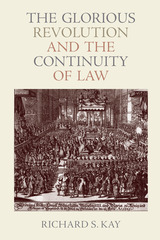
The Glorious Revolution and the Continuity of Law
Richard S. Kay
Catholic University of America Press, 2014
The Glorious Revolution and the Continuity of Law explores the relationship between law and revolution. Revolt - armed or not - is often viewed as the overthrow of legitimate rulers. Historical experience, however, shows that revolutions are frequently accompanied by the invocation rather than the repudiation of law. No example is clearer than that of the Glorious Revolution of 1688-89. At that time the unpopular but lawful Catholic king, James II, lost his throne and was replaced by his Protestant son-in-law and daughter, William of Orange and Mary, with James's attempt to recapture the throne thwarted at the Battle of the Boyne in Ireland. The revolutionaries had to negotiate two contradictory but intensely held convictions. The first was that the essential role of law in defining and regulating the activity of the state must be maintained. The second was that constitutional arrangements to limit the unilateral authority of the monarch and preserve an indispensable role for the houses of parliament in public decision-making had to be established. In the circumstances of 1688-89, the revolutionaries could not be faithful to the second without betraying the first. Their attempts to reconcile these conflicting objectives involved the frequent employment of legal rhetoric to justify their actions. In so doing, they necessarily used the word "law" in different ways. It could denote the specific rules of positive law; it could simply express devotion to the large political and social values that underlay the legal system; or it could do something in between. In 1688-89 it meant all those things to different participants at different times. This study adds a new dimension to the literature of the Glorious Revolution by describing, analyzing and elaborating this central paradox: the revolutionaries tried to break the rules of the constitution and, at the same time, be true to them.
[more]
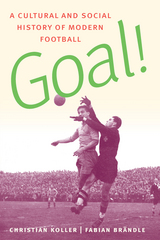
Goal!
Christian Koller
Catholic University of America Press, 2015
Goal! covers the history of the beautiful game from its origins in English public schools in the early 19th century to its current role as a crucial element of a globalized entertainment industry. The authors explain how football transformed from a sport at elite boarding schools in England to become a pastime popular with the working classes, enabling factories such as the Thames Iron Works and the Woolwich Arsenal to give birth to the teams that would become the Premier League mainstays known as West Ham United and Arsenal. They also explore how the age of amateur soccer ended and, with the advent of professionalism, how football became a sport dominated by big clubs with big money and with an international audience.
[more]
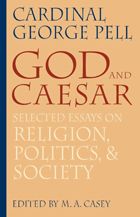
God and Caesar
Selected Essays on Religion, Politics, & Society
George Pell
Catholic University of America Press, 2007
Drawing on a deep knowledge of history and human affairs, the essays pinpoint the key issues facing Christians and non-believers in determining the future of modern democratic life
[more]
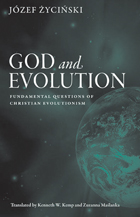
God and Evolution
Fundamental Questions of Christian Evolutionism
Jozef Zycinski
Catholic University of America Press, 2006
Written by Archbishop Józef Zycinski of Lublin, this book offers an important and insightful examination of the basic philosophical questions involved in the relation between evolutionary theory and the Christian religion.
[more]
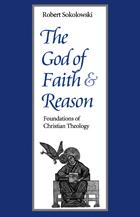
The God of Faith and Reason
Robert Sokolowski
Catholic University of America Press, 1995
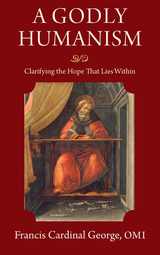
A Godly Humanism
Clarifying the Hope That Lies Within
Francis E. George
Catholic University of America Press, 2015
For Francis Cardinal George, the Catholic Church is not a movement, built around ideas, but a communion, built around relationships. In A Godly Humanism, he shares his understanding of the Church in lively, compelling prose, presenting a way to understand and appreciate the relationships of God to human beings and of human beings to one another. These loving relationships are continually made present to us in and through the Church, from the time of Jesus' first disciples down to our own day. We are introduced to how the spiritual and intellectual life of Christians, aided in every generation by the Holy Spirit working through the Apostles and their successors, resist the danger of splitting apart from one another. Though they take different outward forms at different times, both wisdom and holiness are made possible for every Christian of every station of life. Sign-posting his conversation by the milestones of his own spiritual and intellectual journey, Cardinal George invites us to view the Church and her history in ways that go beyond the categories of politics - through which we find merely human initiative, contrivance, and adjustment - and rather to see the initiative as God's first and foremost. God is the non-stop giver, we are non-stop recipients of his gifts, and the recent popes, no less than the Father of the Church, have made every effort to make us aware of the graces - that is, of the unearned benefits - that God confers on us as Catholics, as Christians, as believers, and simply as human persons. Pope Francis, he reminds us, contrasts human planning with God's providence, and this book is at once an exposition of that providence and a personal response of gratitude for the way it has operated in one man's life.
[more]
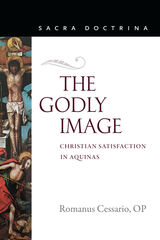
The Godly Image
Christian Satisfaction in Aquinas
Romanus Cessario
Catholic University of America Press, 2020
Christian satisfaction stands at the center of the Church’s teaching about salvation. Satisfaction pertains to studies about Christ, redemption, the Sacraments, and pastoral practice. The topic also enters into questions about God and the creature as well as about the divine mercy and providence. Somewhat neglected in the period after Vatican II, satisfaction now appears to scholars as the forgotten key to entering deeply into the mystery of Christ and his work. Seminarians especially will benefit from studying the place satisfaction holds in Catholic life.
Further, ecumenical work requires a proper understanding of the place that satisfaction holds in Christian theology. Various factors operative since the sixteenth century have worked to displace satisfaction almost entirely from reformed practice and theology. To address such concerns, The Godly Image, has, over the past several decades and more, done a great deal to put satisfaction within its proper context of image-restoration. That is, to interpret satisfaction within the context of the divine mercy and not the divine justice. This unique contribution to satisfaction studies owes a great deal to the achievement of Saint Thomas Aquinas. In this sense, the book enacts a retrieval of the theology of the high classical period. Like much of Aquinas’s refined teaching, a proper understanding requires appeal to the commentatorial tradition that follows him. Interested students will find in this study the touchstones for further studies of these authors.
The Godly Image aims also to distinguish the theology of Aquinas from that of the medieval author with whom the notion of satisfaction remains mostly identified, that is, Anselm of Canterbury. Although not a developed focus of the book’s contents, the attentive reader will recognize that Aquinas treats Saint Anselm with a reverential reading, even as the Common Doctor moves significantly away from interpretations of satisfaction that suggest that an angry God exacts from his innocent Son a painful substitutional penalty for a fallen human race.
[more]
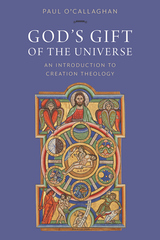
God's Gift of the Universe
An Introduction to Creation Theology
Paul O'Callaghan
Catholic University of America Press, 2021
There are many ways of understanding the reality of the world we live in and experience. Science, philosophy, art all offer us ample descriptions, explanations and intuitions. But Christian believers go beyond all that, for they attempt to understand the origins of the universe in terms of the creation of the world by God. Revelation tells us what God had in mind when he made the world ex nihilo, without presuppositions of any kind. God’s Gift of the Universe attempts to present the principal elements and stages of creation theology. The doctrine is to be found fundamentally, of course, in Scripture, both Old and New Testament, which describes the world in the light of God’s word. Yet since God actually gave existence to the world, down to the last detail, our reflection on God’s word not only explains the reality of creation, how it works, its nature, as science does. It also explains how creation came into being in the mind and heart of the Triune God, and, ultimately, why God created the world.
In God’s Gift of the Universe, a considerable effort has been spent throughout the book on the Christological and Trinitarian aspects of creation, particularly in the theology of Church Fathers. Creation is presented besides in a deeply eschatological key, for God created the world for purpose of making his glory eternally manifest. The book also considers the way God ‘intervenes’ in the life of the created world, through conservation in being and providence. The meaning of time, matter and spirit are considered. The need for ecological awareness is central. One aspect of the mystery of creation that receives special attention is the presence of evil in the world. This is of particular importance once we accept that God made the world, whole and entire, thus assuming responsibility for the world as it is. The origin of evil through the sin of spiritual creatures provides the ultimate though not the only explanation of the mystery of evil. Particular consideration is given to the reality of ‘original sin’.
[more]
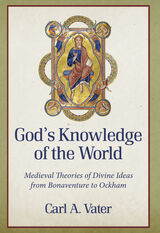
God's Knowledge of the World
Medieval Theories of Divine Ideas from Bonaventure to Ockham
Carl A. Vater
Catholic University of America Press, 2022
A theory of divine ideas was the standard Scholastic response to the question how does God know and produce the world? A theory was deemed to be successful only if it simultaneously upheld that God has perfect knowledge and that he is supremely simple and one. In articulating a theory of divine ideas, Carl Vater answers two sorts of questions. First, what is an idea? Does God have ideas? Are there many divine ideas? What sort of existence does an idea enjoy? Second, he answers questions about the scope of divine ideas: does God have ideas of individuals, species, genera, accidents, matter, evil, etc.? How many divine ideas are there?
These questions cause the Scholastic authors to articulate clearly, among other things, their positions on the nature of knowledge, relation, exemplar causality, participation, infinity, and possibility. An author’s theory of divine ideas, then, is the locus for him to test the coherence of his metaphysical, epistemological, and logical principles. Many of the debates over divine ideas have their roots in disagreements over whether a given theory adequately articulates one of the underlying positions or the overall coherence of those positions. Peter John Olivi, for example, argues that his predecessors’ theories of knowledge and theories of relations are at odds, and this critique results in a major shift in theories of divine ideas.
God's Knowledge of the World examines theories of divine ideas from approximately 1250–1325 AD (St. Bonaventure through Ockham). It will be the only work dedicated to categorizing and comparing the major theories of divine ideas in the Scholastic period.
[more]
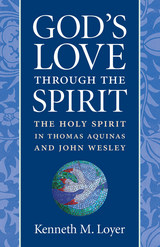
God's Love through the Spirit
Kenneth M. Loyer
Catholic University of America Press, 2014
Although the doctrine of the Holy Spirit has often been a neglected subject in theology, it remains vital for understanding both the Christian confession of God as Trinity and the nature of the Christian life. In view of those two topics, God's Love through the Spirit examines the relationship between love and the person and work of the Holy Spirit in Thomas Aquinas and John Wesley - two very different figures whose teachings on the Spirit and the Christian life are found to be, on the whole, surprisingly compatible. An investigation into Aquinas's amor-based pneumatology, including a groundbreaking analysis of his recently discovered Pentecost sermon, and a fresh assessment of the doctrine of sanctification in Wesley show that in distinctive yet largely complementary ways, Aquinas and Wesley provide resources that can be used to reclaim a richer pneumatology, specifically in relation to the theological virtue of love.
[more]
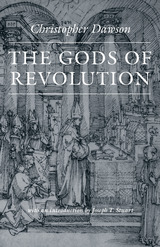
The Gods of Revolution
Christopher Dawson
Catholic University of America Press, 2015
Please fill in marketing copy
[more]
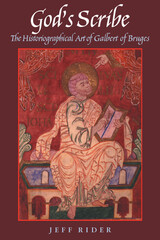
God's Scribe
The Historiographical Art of Galbert of Bruges
Jeff Rider
Catholic University of America Press, 2001
Intended as a companion volume to the De multro, the book provides an outline of the Flemish crisis of 1127-28 and summarizes what is known about Galbert. It traces the elaboration of the De multro from a set of wax notes to a nearly completed chronicle.
[more]
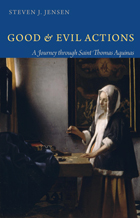
Good and Evil Actions
A Journey through Saint Thomas Aquinas
Steven J. Jensen
Catholic University of America Press, 2010
In Good and Evil Actions, Steven J. Jensen navigates a path through the debate, retrieving what is of value from each interpretation
[more]
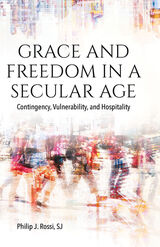
Grace and Freedom in a Secular Age
Contingency, Vulnerability, and Hospitality
Philip J. Rossi
Catholic University of America Press, 2022
In the course of a long and distinguished academic and civic career, the Canadian philosopher Charles Taylor has been, for articulate atheists and learned believers alike, an incisive, insightful, gracious, and challenging conversation partner on issues that arise at the intersection and interaction of religion, society, and culture.
Grace and Freedom in a Secular Age offers a concise exposition of key ideas – contingency, otherness, freedom, vulnerability and mutuality – that inform his probing analyses of the dynamics of religious belief and religious denial in the pervasive contemporary culture he calls a “a secular age,” within which religious belief and practice have, for many, become just an option. Those ideas provide the basis from which Rossi argues that, despite a clear-eyed recognition of the deep fractures of meaning and the pervasive fragmentation of once stable societal connections that a secular age has brought in its wake, Taylor also sees and affirms strong grounds for hope in a healing of our broken and fractured world and for the possibilities—and the importance of—active human participation in that healing. Taylor points to signs indicative of potent re-compositions and renewals taking place in religious belief and practice from its interaction with the dynamics of secular culture, particularly ones that make possible radical enactments of deeper human solidarity and mutuality, of which the one most often potent is the reconciliation of enemies. In pointing out these signs, Taylor suggests a richly expansive reading of the Christian doctrine of Creation, as it marks the radical contingency of all that is upon a freely bestowed divine self-giving: Creation is the ongoing enactment of the divine hospitality of the Triune God.
[more]
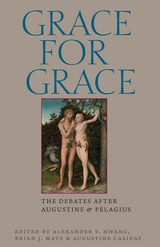
Grace for Grace
Alexander Y. Hwang
Catholic University of America Press, 2014
The contributors to Grace for Grace focus on the debates on grace and free will inspired by Augustine's later teachings on grace and the various reactions to it. In both popular and scholarly literature, the conflict has been traditionally referred to as the "Semi-Pelagian Controversy." For several decades, scholars have distanced themselves from that overly-simplistic and inaccurate portrayal. This book intends to solidify a disparate movement of scholarly thought and offer a secure basis for renewed study of the persons, texts, and events of this critical period in the reception of Augustine in the Early Middle Ages. This volume brings together new perspectives, based on fresh study of a wealth of primary sources, from an international team of scholars to explore the intra-church debates over grace and free will, after Augustine and Pelagius.
[more]
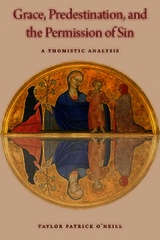
Grace, Predestination, and the Permission of Sin
A Thomistic Analysis
Taylor O'Neill
Catholic University of America Press, 2019
Grace, Predestination, and the Permission of Sin seeks to analyze a revisionist movement within Thomism in the 20th century over and against the traditional or classical Thomistic commentatorial treatment of physical premotion, grace, and the permission of sin, especially as these relate to the mysteries of predestination and reprobation. The over-arching critique leveled by the revisionists against the classic treatment is that Bañezian scholasticism had disregarded the dissymmetry between the line of good (God's causation of salutary acts) and the line of evil (God's permission of defect and sin). The teaching of St. Thomas is explored via intimate consideration of his texts. The thought of St. Thomas is then compared with the work of Domingo Bañez and the foremost 'Bañezian' of the 20th century, Reginald Garrigou-Lagrange. The work then shifts to a consideration of the major players of the revisionist treatment, including Francisco Marín-Sola, Jacques Maritain, and Bernard Lonergan. Jean-Herve Nicolas is also taken up as one who had held both accounts during his lifetime. The work analyzes and critiques the revisionist theories according to the fundamental tenets of the classical account. Upon final analysis, it seeks to show that the classical account sufficiently distances God's causal role in regard to free salutary acts and His non-causal role in regard to free sinful acts. Moreover, the revisionist account presents significant metaphysical problems and challenges major tenets of classical theism, such as the divine omnipotence, simplicity, and the exhaustive nature of divine providence. Finally, the implications of the traditional view are considered in light of the spiritual life. It is argued that the classical account is the only one which provides an adequate theological foundation for the Church's robust mystical and spiritual tradition, and in particular, the abandonment to divine providence.
[more]
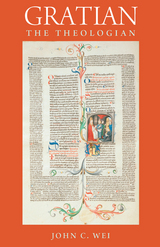
Gratian the Theologian
John C. Wei
Catholic University of America Press, 2016
Gratian the Theologian shows how one of the best-known canonists of the medieval period was also an accomplished theologian. Well into the twelfth century, compilations of Church law often dealt with theological issues. Gratian's Concordia discordantium canonum or Decretum, which was originally compiled around 1140, was no exception, and so Wei claims in this provocative book. The Decretum is the fundamental canon law work of the twelfth century, which served as both the standard textbook of canon law in the medieval schools and an authoritative law book in ecclesiastical and secular courts. Yet theology features prominently throughout the Decretum, both for its own sake and for its connection to canon law and canonistic jurisprudence.
[more]
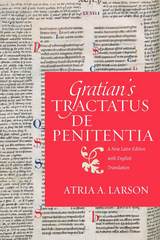
Gratian's Tractatus de penitentia
Atria A. Larson
Catholic University of America Press, 2016
Gratian's Decretum is one of the major works in European history, a text that in many ways launched the field of canon law. In this new volume, Atria Larson presents to students and scholars alike a critical edition of De penitentia (Decretum C.33 q.3), the foundational text on penance, both for canon law and for theology, of the twelfth century. This edition takes into account recent manuscript discoveries and research into the various recensions of Gratian's text and proposes a model for how a future critical edition of the entire Decretum could be formatted by offering a facing-page English translation. This translation is the first of this section of Gratian's De penitentia into any modern language and makes the text accessible to a wider audience. Both the Latin and the English text are presented in a way to make clear the development of Gratian's text in various stages within two main recensions. The edition and translation are preceded by an introduction relating the latest scholarship on Gratian and his text and are followed by three appendices, including one that provides a transcription of the relevant text from the debated manuscript Sankt Gallen, Stiftsbibliothek 673, and one that lists possible formal sources and related contemporary texts. This book provides a full edition and translation of the text studied in depth in Master of Penance: Gratian and the Development of Penitential Thought and Law in the Twelfth Century (CUA Press, 2014) by the same author.
[more]
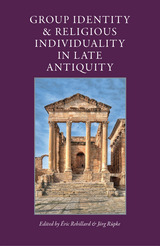
Group Identity and Religious Individuality in Late Antiquity
Eric Rebillard
Catholic University of America Press, 2015
To understand the past, we necessarily group people together and, consequently, frequently assume that all of its members share the same attributes. In this ground-breaking volume, Eric Rebillard and Jörg Rüpke bring renowned scholars together to challenge this norm by seeking to rediscover the individual and to explore the dynamics between individuals and the groups to which they belong.
[more]
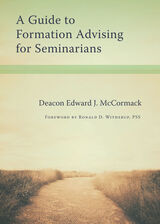
A Guide to Formation Advising for Seminarians
Edward J. McCormack
Catholic University of America Press, 2020
The future of the Church depends, in part, on forming future priests and ministers who are ready to accompany, lead, and love the People of God. Formation advising is one important part of that work. A Guide to Formation Advising for Seminarians/Seminary Faculty offers a practical guide to formation advising as a ministry of accompaniment, participation, and evaluation. Deacon Edward McCormack offers a comprehensive introduction to the ministry of formation advising for seminarians studying for priestly ministry. These volumes are for men and women who are new to the ministry of formation advising. The recent Vatican guidelines for seminary formation call for professional accompaniment of seminarians throughout their formation. This book explains in concrete detail how to do this through the entire formation process.
Beginning with an overview of the formation process, A Guide to Formation Advising for Seminarians/Seminary Faculty explains the role of the formation advisor and the skills required for that ministry. It describes the various ways the formation advisor accompanies a person through the formation process. McCormack also provides concrete suggestions for how to promote in seminarians’ active participation in the process. Formators will also find explanation of the evaluation process with a style sheet and examples of written evaluations. The handbook contains an annotated bibliography on all the major topics a formation advisor comes across.
[more]
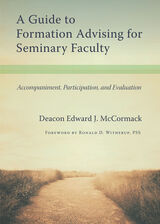
A Guide to Formation Advising for Seminary Faculty
Accompaniment, Participation, and Evaluation
Edward J. McCormack
Catholic University of America Press, 2020
The future of the Church depends, in part, on forming future priests and ministers who are ready to accompany, lead, and love the People of God. Formation advising is one important part of that work. A Guide to Formation Advising for Seminarians/Seminary Faculty offers a practical guide to formation advising as a ministry of accompaniment, participation, and evaluation. Deacon Edward McCormack offers a comprehensive introduction to the ministry of formation advising for seminarians studying for priestly ministry. These volumes are for men and women who are new to the ministry of formation advising. The recent Vatican guidelines for seminary formation call for professional accompaniment of seminarians throughout their formation. This book explains in concrete detail how to do this through the entire formation process.
Beginning with an overview of the formation process, A Guide to Formation Advising for Seminarians/Seminary Faculty explains the role of the formation advisor and the skills required for that ministry. It describes the various ways the formation advisor accompanies a person through the formation process. McCormack also provides concrete suggestions for how to promote in seminarians’ active participation in the process. Formators will also find explanation of the evaluation process with a style sheet and examples of written evaluations. The handbook contains an annotated bibliography on all the major topics a formation advisor comes across.
Beginning with an overview of the formation process, A Guide to Formation Advising for Seminarians/Seminary Faculty explains the role of the formation advisor and the skills required for that ministry. It describes the various ways the formation advisor accompanies a person through the formation process. McCormack also provides concrete suggestions for how to promote in seminarians’ active participation in the process. Formators will also find explanation of the evaluation process with a style sheet and examples of written evaluations. The handbook contains an annotated bibliography on all the major topics a formation advisor comes across.
[more]

A Guide to John Henry Newman
His Life and Thought
Juan R. Velez
Catholic University of America Press, 2022
John Henry Newman (1801-1890), renowned thinker and writer, Anglican clergyman and later Roman Catholic priest and cardinal, has had a lasting influence on both Anglicans and Catholics, in the fields of literature, education, and theology. On October 13, 2019, Pope Francis declared him a saint in Rome.
Appealing to both the student and the scholar, A Guide to John Henry Newman provides a wide range of subjects on Newman’s life and thought relevant for our times and complementary to biographies of Newman. The contributors include authors from many different disciplines such as theology, education, literature, history, and philosophy, highlighting the wide range of Newman’s work. These authors offer a positive assessment of Newman’s thought and contribute to the discussion of the recent scholarship of others.
A Guide to John Henry Newman will interest educated readers and professors alike, and serve as a text for college seminars for the purpose of studying Newman.
[more]
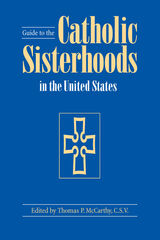
Guide to the Catholic Sisterhoods in the United States, Fifth Edition
Thomas P. McCarthy, C.S.V.
Catholic University of America Press, 2002
In this edition, the communities of sisters have been arranged according to their general apostolic work, viz., contemplative, domestic, foreign and home missions, nursing, retreat and social work, teaching, and writing and publications.
[more]

Guiding to a Blessed End
Andrew of Caesarea and His Apocalypse Commentary in the Ancient Church
Eugenia Scarvelis Constantinou
Catholic University of America Press, 2013
In this interesting and insightful work, Eugenia Scarvelis Constantinou, the leading expert on Andrew of Caesarea and the first to translate his Apocalypse commentary into any modern language, identifies an exact date for the commentary and a probable recipient. Her groundbreaking book, the first ever written about Andrew, analyzes his historical milieu, education, style, methodology, theology, eschatology, and pervasive and lasting influence. She explains the direct correlation between Andrew of Caesarea and fluctuating status of the Book of Revelation in Eastern Christianity through the centuries.
[more]
READERS
Browse our collection.
PUBLISHERS
See BiblioVault's publisher services.
STUDENT SERVICES
Files for college accessibility offices.
UChicago Accessibility Resources
home | accessibility | search | about | contact us
BiblioVault ® 2001 - 2024
The University of Chicago Press









